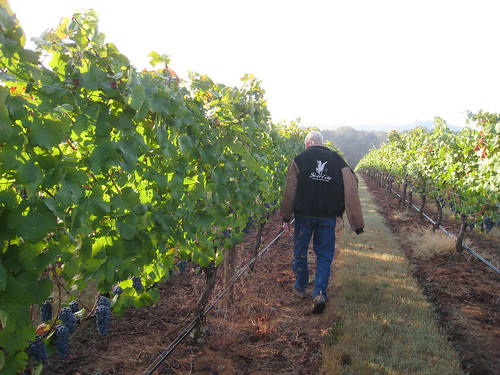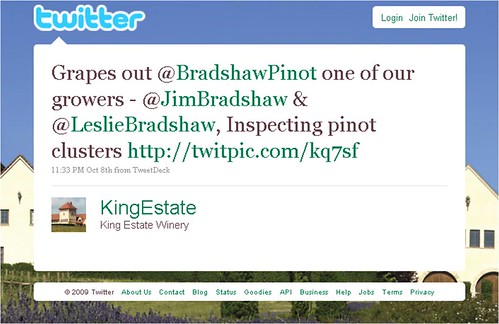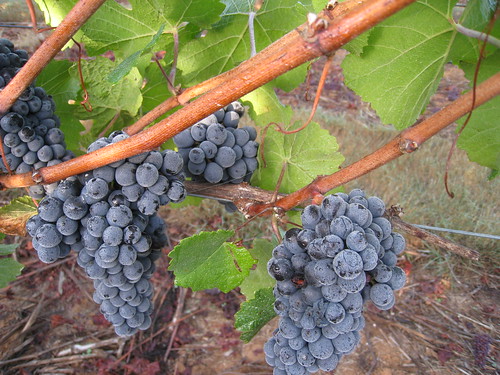When King Estate first approached JESS3 to work on their Vineyard Designate label, it was a no-brainer for us. The label was in fact for a wine made with my family’s own Bradshaw Vineyards pinot noir grapes. The project took off from there.
In wanting to share both our branding explorations, as well as insights about the process of running a vineyard, I sat down with my dad for this exclusive interview. My middle name is Ann and my dad’s middle name is Earl, so you’ll see us as LAB and JEB from here on out (family nicknames, as well).

LAB: What drew you to the Willamette Valley as a region and as a place to cultivate grapes for wine?
JEB: My wife (your mom) and I began looking for wine grape property after starting the planning process in the early 1970’s while managing a walnut farm in Amador County, CA. Our search took us through many of the existing wine regions in central and northern California. During a chance conversation with an old high school chum, who happened to be a fine wine salesman in Oregon, we decided to broaden our horizons seeing an opportunity to get into a relatively new and very promising wine growing region. We “kicked a lot of dirt” up and down the Willamette Valley and found the perfect spot to not only raise premium wine grapes but also to raise our “premium” children, Leslie (you) and Jennifer.
LAB: How did the partnership with King Estate come about?
JEB: The Oregon wine growers, especially back in the late 80’s, have always been open, friendly and ready to share information. The down side is you can ask ten different growers what the best trellis system is and you would get ten different answers. I sought out the best people doing things the “right” way. This led us to what would be a long term friendship with the then vineyard manager of King Estate. From the beginning King Estate went about developing their vineyards without cutting corners. They were in for the long haul and their methods reflected this philosophy. We new intuitively that if we were going to be successful in the wine growing business we needed to make quality our highest priority and it has paid off. Our original trellis design came from King Estate as did our vines for our foundation blocks. The rest, as they say, is history.

LAB: Can you tell us more about the types of wine produced in the region and how they may differ from other wines from around the country and world?
JEB: Maybe we should talk about similarities before we talk about differences. The Willamette Valley is often compared to Burgundy France when it comes to growing the noble Pinot Noir grape. The areas are on essentially the same latitude and share similar climates. The long, relatively cool, growing season with long daylight hours at this latitude, 45 degrees north, are the essential ingredients for the grapes to fully develop their characteristic flavors. The difference between the two areas are most pronounced in their terroir, which translates into the expression of the unique place they are grown – the soil type and micro climate. When we compare other regions in the country or the world a general statement can be made that pinot noir, like most grapes, can be grown in a variety of places and climates but there are only a few places in the world, some discovered like Burgundy and the Willamette Valley, and some yet undiscovered, that can bring the fruit to its full potential and capture the elusive balance that makes great pinot noir wine. It is well known in the wine world that great pinot noir is grown “on the edge”, on the edge of weather related catastrophes that come with the more nothern latitudes.

LAB: What type of time commitment does running the Bradshaw Vineyards require by season?
JEB: Growing good pinot noir grapes is a labor of love and, at times, a little insanity helps. Growing great quality fruit takes it a step further. It perhaps can best be broken down by the number of times a vine must be “visited” with hand work, primarily in the growing season from late April through Harvest in mid October. Each vine requires approximately 15 personal visits during the season. Even if the visit is only one minute this equates to 15 minutes x 20,000 vines = 5,000 hours. And this does not take into account the trellis adjustments, tractor time, maintaining the area between the rows, winter pruning, etc., etc.
LAB: Do you have any plans to partner with the King Estate on any future wines?
JEB: Our relationship with King Estate is planned to be a long one. KE grows great fruit on their estate but they had the foresight to gather a few select growers who can bring unique premium quality fruit that can can be converted into unique wines to offer their clients.
LAB: What role do you think an appealing packaging and label play in the successful sale of a wine?
JEB: If I recall the statistic correctly, once the buyers eye is drawn to the label on the shelf the sale is somewhere between 60 – 80% made. That, I think, answers the question. It is not only helpful, it is critical.
LAB: Where can one purchase this particular wine?
JEB: Our first vintage with KE was 2009. This wine, King Estate Reserve Pinot Noir / Bradshaw Vineyards Designate, is being released this August. I understand the primary distribution will be through their wine club, called the Tower Club. More information on the Tower Club is available on the King Estate website.
LAB: What is it like running a family business?
JEB: The short answer is “it’s great!” I’ve also heard the horror stories of family businesses that are less than pleasant. I think it is the special combination of talents and personalities found in our family that provides a special chemistry. And, you know what, it’s fun and rewarding to be able to share the trials and tribulations and hopefully establish a legacy for future generations.

Tags: bradshaw vineyards, king estate, leslie bradshaw, pinot noir
Join the Conversation